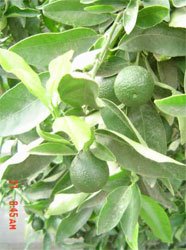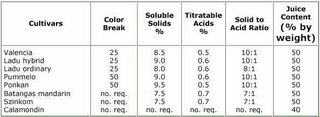
Citrus thrives well in tropical and subtropical climates. Some of the best quality oranges are grown in the non-humid, irrigated, subtropical areas such as the Mountain Province. It can be grown in our four types of climate but areas with well-distributed rainfall throughout the year are best. Those with distinct and long dry periods should bank heavily on irrigation to raise high quality citrus fruits. Fields of citrus in the country are generally low. Citrus plantations are run on modern and intensive technology to allow their produce to compare favorably with those of developed countries.
VALUE
Citrus fruits are rich in vitamins, especially vitamin C. Its mild acid and bitter taste favorable to digestion and blood circulation. Citrus peels are rich in pectin, valuable in making jellies, marmalades, candies, jams and pharmaceutical preparations.
VARIETIES
Several species are highly adapted to the country. The most important include calamondin, mandarin, pummelo, lemon and lime.
* Calamondin Locally known as "kalamansi" or "kalamundin", this is a small tree with upright branches. Its leaves are broadly oval, dark green above and pale green below. Its fruits are small subglobos, ranging from 0.3 to 3.5 cm long and 3.8 to 4.5 cm in diameter. Each fruit has 7 - 10 segments with a very thin rind. The juiceis acidic and usually use for flavoring.
* Mandarin Actually it is native to China. Its local names are "sintones" or "dalanghita". This tree has a dense crown with slender branches, with a few row to ovate and pointed. The fruit is flattened and turns yellow or reddish orange when mature. It consists of 10 - 14 segments easily separated from one another to form an open core. The rind is loose and can be easily removed. Its popular varieties include Szinkom, Ladu, Batangas, and King.
* Pummelo It originated from the Malayan and East Indian archipelago. Locally, it is known as "lukban" or "suha". Its tree which is medium to large and spreading, bears fruit that is large, round to pear-shaped and with a thick and spongy rind. The segments usually open at the sutures. The flesh is commonly firm with large vesicles and with low to high juice content. It usually matures from October to March. Its outstanding varieties include Amoy, Siamese, Pink and Suiwui Luk.
* Sweet Orange Locally called "dalandan" or "kahel", it originated from China. Its varieties cultivated in the country are Hamlin, Pineapple and Valencia. Its typical tree is moderately vigorous, medium-large and productive. The fruit is usually medium-sized and spherical to slightly obovate. Valencia type which is of excellent quality may be seedless pr may have five to six large seeds.
* Lemon It is grown primarily for its acidic juice. The tree is medium-sized, elliptical to oblong, sometimes obovate with a short neck or low collar at the base. It usually has 10 segments and the rind turns yellow when it ripens. Its flesh is greenish yellow, tender and juicy. Best commercial varieties grown here are Eureka and Lisbon.
* Lime Locally known as "dayap", this common tree is small and bears seedy small fruits with a very thin, aromatic rind. Its flesh is juicy and very acidic.
PROPAGATION
Citrus can be propagated by seed budding, grafting and marcotting. Commercially, seed budding, which is universally applicable to all citrus species, is the preferred method. Although grafting and marcotting produce satisfactory materials, and therefore may be recommended only for small-scale propagation. Shield budding unites a desired scion variety with a suitable rootstock. Success depends on the skill of the propagation and the conditions of the scion and the rootstock.
1. Rootstock
* Must be compatible with the scion variety allowing good growth, long life, good yield and good fruit qualities;
* Seeds must be readily available, preferably high poly-embryonic to get uniform seedlings and with high percentage and germination;
* Must be adaptable to a wide range of soil depth, texture, structure, pH, salinity, moisture, and nutrient supply; and
* Must be resistant to soil-borne diseases, such as Phytophthora grimmosis.
Budwood should be taken from parent trees which:
* Hold a record satisfactory production over a period of a t least 5 years;
* Are free from systematic diseases; and
* Have true-type fruit characters.
Budwood should be plucked from green, vigorous, second-flush growth. Its leaves should be clipped and the budwood is collected. It should be immediately labeled, indicating the name of the variety, source of budwood, and date of collection. Only freshly cut budwood should be used. If it needs storage, it should be kept by wrapping it in moist sphagnum moss or similar materials, put in polyethylene bag and kept in a cool place. This will last for 10 days.
2. Care
By means of shallow cultivation, the nursery is always kept free. Weekly, seedlings are sprayed with the appropriate insecticides to control pests and leaf cutting insects. Every 2 weeks, copper fungicide is mixed with the insecticide to control diseases. Once a month, at time of weeding, one (1) level tbsp 5 g urea is applied around each seedling.
From a budded plant, tape is removed 2 - 3 weeks after budding. If the bud looks fresh and green, the lower half of the tape is left intact until the bud begins to grow. When the budding reaches about 10 cm, lopping can be done to hasten growth. Only one vigorous scion should be allowed. Cultural practices such as weeding, cultivation, watering and fertilization should be continued to promote the development of the plant. To avoid infestation, spraying of appropriate insecticide should be done every 2 weeks.
3. Orchard Establishment
Planting can be done anytime of the year if irrigation is available. Balled or bare-rooted budlings are planted in holes big enough and always enriched with a handful of complete fertilizer, high in phosphorous. Topsoil is used to fill the holes and this is pressed down firmly to avoid large air spaces. Newly planted budlings should be watered immediately.
Planting of citrus follows a certain arrangement in which trees are set out in the orchard. Systems used include square, rectangular, triangular, and quincunx. Rectangular and square systems are to be used where intercropping is to be done. In rectangular and square systems, the rows of trees are set at right angles to each other. In a triangular system, trees are set at the corners of equilateral triangle. In the quincunx system, four trees are set in a square and a tree is planted in the center.
4. Care for the Bearing Groves
Care for the bearing groves is observed through the following:
a. Irrigation. This is important to avoid water stress. Trees are watered until the rainy season begins. Irrigation can be through furrow, hose, or sprinkle.
b. Fertilization. Plants need 2 - 3 fertilizer applications each year.
* First, when the rainy season begins;
* Second, during the middle of the rainy season; and
* Third, when the rainy season is about to end. Fertilizer can be applied or sprayed. Fertilizer can be applied directly or sprayed.
Common Role of Fertilization in Orchard for Each Application

c. Pruning. Pruning means removing diseased and dead twigs, branches, and leaves which are unproductive and are less exposed to sunlight. Best time for pruning is during the dry season or after harvest.
d. Spraying. A certain spray program should be strictly observed. Two or three types of chemicals against a particular pest should be alternated to avoid developing resistance of the chemicals.
e. Propping and Setting of the Windbreaks. To prevent the crop from touching the ground and the branches heavily laden with fruits. Ipil-ipil windbreaks on the windward sides of the orchard can be set up.
5. Pests and Diseases
Many important pests limit citrus growth. A systematic virus-like disease called leaf molting with its insect nectar was responsible for the decline of more than half a million citrus trees. Efficient pest management simply requires an understanding of the nature and cause of diseases, conditions that favor the spread of the diseases and the most effective control measures. Knowledge of the most common and destructive insect pests therefore becomes vital.
To prevent unnecessary injury to plants when using pesticides, make sure that instructions and recommendations in pesticide packages and containers are followed.
6. Harvesting
Periodically, sampling has to be done to check whether fruits are ready for harvesting. Generally, citrus trees start bearing fruits 3 - 5 years from planting and can be harvested 5 - 6 months from flowering depending on the species and the environment. Unlike other fruits, citrus does not ripen further after it has been harvested, so it is important that it is picked at the right stage of maturity. Maturity indices include color, juice content, level of soluble solid (sugar), titratable acidity, and solids to acid ratio.
Table of Minimum Maturity Requirements for Local Citrus

Best time to harvest citrus is from 8 a.m. to 3 p.m., when the dew has dried up and fruits have lost their turgor. Fruits, which are frigid, are easily bruised resulting in brown patches on the rind, which indicate direct injury to the oil cells in the rind. This lowers fruit quality.
The proper way to harvest citrus is by pulling or clipping from the stem. "Twist, jerk and pull", experts say, is the general rule. Use of hand gloves reduces to a great extent injuries on the peel of citrus. Canvas bags of suitable sizes with hooks at the bottom are best for transporting fruits to large, padded, field containers.
source: Dept. of Agriculture
Related Links:
Agri Business
No comments:
Post a Comment